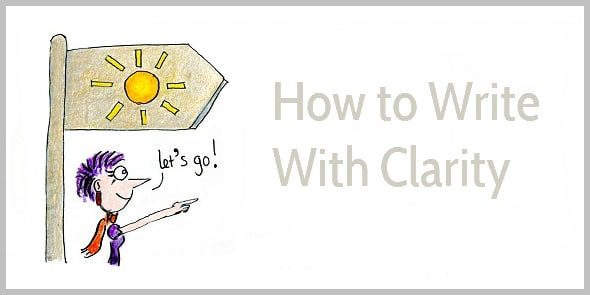
It happens to the best writers sometimes.
We try to simplify our message. We do our best to write with clarity.
But when web visitors read our content, they get confused.
Web readers are in a hurry. They get easily distracted. So we must make our web content so simple, so crystal-clear that even readers racing around the internet get hooked.
Communicating with clarity is probably one of the most difficult writing tasks.
Our efforts get sabotaged easily, without us noticing it. We try to communicate too much. We try to impress with our knowledge. And we think we know what we want to say, but the truth is that we haven’t figured out the essence of our message.
When you follow the 4-step approach below, your content becomes clearer, simpler and more persuasive. Readers start following your advice. They take action. They buy from you.
Shall I explain?
Step 1. Clarify your destination and define the shortest route
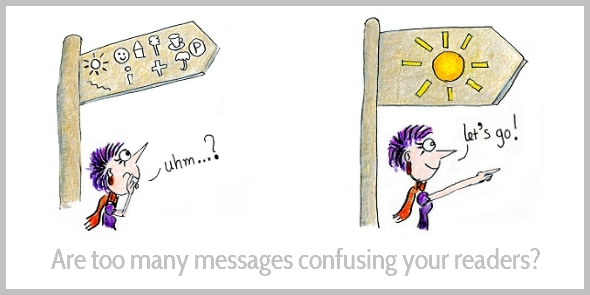
What’s your writing process?
Some people get an idea, and simply start writing. That’s freewriting, and it works well for some people. However, freewriting can lead to a complicated process of writing, reverse outlining, revising, rewriting, and editing. This process guzzles up time, and there’s no guarantee that the content will become clear and persuasive.
A quicker way is to plan your content first:
- Write down the purpose of your content in one or two sentences
- Create a list or mindmap of what you want to include
- Review the list and narrow down your topic—your initial list or mindmap is often too unwieldy, so you must cull irrelevant ideas
- Review your purpose and your short list of content—will your content deliver on your promise? Or should you narrow down your purpose?
Irrelevant ideas lead readers astray. They might get confused, or worse, click away. So keep your content focused on one simple and clear message.
Step 2. Set up signposts at each junction
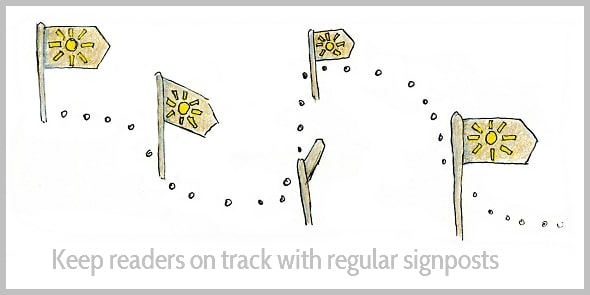
Travelers feel lost when they have no clue of where they are.
With your readers, it’s the same. They want to know where they are, and they want to know where they’re heading next.
Firstly, readers need to get an instant feel of what a page is about as soon as they arrive:
- When visitors arrive on your home page, they want to know what you’re about. For instance: Relaxed Holidays in Dreamland. 365 Days of Sunshine.
- When visitors arrive on a product page, they want to know what you offer. Show a clear picture and use a simple headline describing the product. For instance: 2-person apartment – 100 yards from the beach
- When visitors arrive at a blog post, they want to know what your post is about. Write a headline promising what they’ll learn, such as 10 Top European Destinations for Sun Lovers
Secondly, add sign posts at every junction to keep on track:
- Use clear button copy and link text. For instance, a “next” button is unclear; in contrast, “view apartment details” tells readers immediately what to expect next
- Remind readers why they’re interested in buying from you by sprinkling benefits over your copy
- Blog posts should also remind readers why they should continue to read. The introductory paragraph of this post, for instance, mentioned that writing with clarity can lead to more engaged readers and more sales. This message is repeated, using different phrases, throughout the post.
Without signposts, readers lose interest in your content. Good signposts keep them engaged.
Step 3. Avoid vague route descriptions
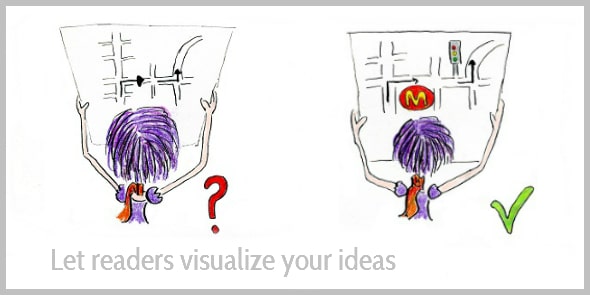
In the good old days, we didn’t have sat nav, and sometimes we had to ask for directions. Do you remember?
More often than not, the directions would leave you confused.
Let’s compare two route descriptions:
- At the third road, turn right. Then at the second junction, turn left.
- After about 300 yards, you’ll see a large McDonald’s at your right. Immediately after the McDonalds, turn right. Go straight at the first junction. Then at the second junction (this one has traffic lights), turn left.
The second description is longer, but it’s more concrete. That’s why it’s far easier to remember.
Writing also needs to be concrete to be understandable:
- Think in pictures—avoid abstract terms and generic descriptions
- Add examples—case studies, mini-stories and examples help make abstract concepts concrete
- Try a metaphor—get inspired by these metaphor examples
Abstract language baffles your readers. Vivid language makes your message memorable.
Step 4. Simplify your words
Write to express, not to impress ~ Gregory Ciotti
At school, we received praise for using complicated words. At college, we read texts full of long and Latinized words.
And that’s how we become our own biggest enemy when it comes to writing with clarity.
If we want readers to reach our destination, then let’s find the simplest route.
Would you rather go to a sunny beach?
Or would you go to a place where a big sphere shines full of hot gas comprising hydrogen, helium and small amounts of carbon, nitrogen, oxygen and more?
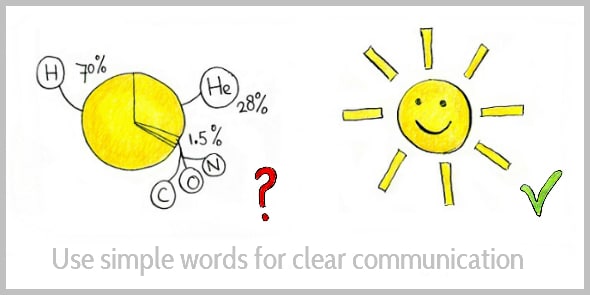
Difficult words make our readers stumble. Long sentences wear them down.
So use simple words and short sentences to communicate your message.
How to write clearly and communicate your message
Ever got lost in a big forest?
Ever stared at a map, wondering where the hell you were? Or were you arguing with your walking companion about whether to turn left or right?
Getting lost in content makes readers feel bad, too.
But there’s one big difference: When you were lost in a forest or city, you were determined to find your way. Readers are less determined. Their minds start wandering, and they click away.
Writing clearly signposted content requires effort. Rethink. Review. Edit. And edit again.
But your extra efforts make your readers happy. They stay engaged. They follow your advice. And they might even buy from you.
So make your content simple and clear.
Because your readers deserve it.
Recommended course:
Enchanting Blog Writing
Learn how to engage, educate, and inspire your readers
“I’m a copywriter who has bought maaaany courses. This was one of THE BEST courses I’ve EVER bought. No doubt about it. The countless examples and activities make this blog writing course killer. Henneke breaks down everything you need to know to write incredible blog posts.”
~ Esat Akan
![]()
“I love how Henneke breaks down complex ideas, and how she reveals the structure behind good writing – this is what I was missing.”
~ Tope
![]()
Recommended reading on writing with clarity:
Show and tell: The #2 fiction tip for business writers
How to share the big picture without boring readers
How to write simply (without dumbing down)
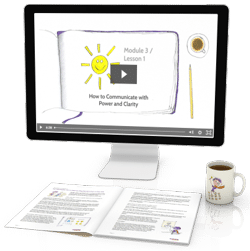


Thank you for all the kindness, you share a vast amount of awareness, and you are a gift to the world of writers and much more. I’m always lifted by your teachings and links to knowledgeable content. Best wishes.
Thank you for your lovely compliment, Jason.
You’re my hero, Henneke.
And, thank you for this post! I’ve pinned it on my wall to remind me of tidying my posts. Oh, and I adore your Henrietta sketches! 🥰
Thanks so much for your lovely comment, Lia. Henrietta says hello to you!
My thanks to Eric, too, for inspiring this! Somehow I missed it when it came out, but I am taking notes now. So helpful….
I love the tiny poem:
Irrelevant ideas lead readers astray.
They might get confused, or worse, click away.
I will memorize it.
One thing this article has shown me is that we must be careful when using metaphor, because it must add clarity and must not invite a side trip or other distractions.
Also, there is no excuse for blaming the reader for not working through adult vocabulary; we must do the work. We must do all we can to stick to one-syllable wording, while not adding redundant, superfluous, unnecessary, repetitive words, haha!
It’s time to realize we are wooing. That plain fact can save our reputation, our writing, and even our reader.
Thanks, so much!
I hadn’t realized a tiny poem was hidden in this post 🙂 What a lovely discovery!
And yes, that’s a good point on metaphors. Thank you for mentioning it. Maybe that’s something I need to add to my blog post about metaphors. I was thinking about updating that post some time.
We have one metaphor that was set to music when I was a child: A spoonful of sugar makes the medicine go down. 🙂
Those are the kinds of metaphors we need, that help the reader want to take our “medicine” and that help it slide down in a fun way.
Thanks for this amazing and helpful post on writing a post with clarity! Recently, I started improving my readability levels realizing the fact that it plays a significant role in getting higher ranking. I also noticed that a readable piece of content is such that maintains clarity at a high level. Simplified words will, of course, help ensure clarify in every piece created. Thanks for those useful tips!
I’m glad you enjoyed this, Sierra. Happy writing!
Another timely post again, Henneke.
I don’t know how you do it, but your posts always seem to address an issue I will be struggling with. Not so much clarity this time, but just the discipline to stick to a process.
Too often I find myself free writing, even when I know the result is seldom satisfactory. This post has given me a nudge to, I guess, go back to the basics and just stick to outlining my posts first.
Thanks for sharing.
I agree with experimenting to see what writing method works best for you. I usually outline (or have a clear idea in my mind), but sometimes freewriting works, too.
Hey Henneke,
Great stuff as always. Thanks much.
You’re welcome 🙂
Hi Henneke,
I have been following you for a couple weeks now and have used your tips in my writing often.
I am here topping up my hit list. Enchanting Marketing has been added.
I don’t see any guest post but maybe I am just missing them. If there aren’t any perhaps I will be the first. I am not in a hurry and am willing to persist.
I appreciate the Snackable Writing Course. It is a great help.
Congratulations on your success,
Barry
Hi Barry
You’re right – I don’t accept guest posts. You can take me off your “hit list” as I’m not planning to change my policy soon 🙂
Thank you for stopping by!
Hi Henneke,
I am going through the Jon Morrow Guest Blog Course and thought it was worth trying. “I have never failed just found 10,000 ways that won’t work” T. Edison.
I left a comment on your post 14 tips and noticed a link to a post on my website. A pleasant surprise.
Thank you very much for that. I really appreciate it greatly.
Barry
Straight to the point, Henneke!
How simple adjustments can make the readers flow and stay engaged.
I am currently working on 3.000+ words content page and I really need to improve signalization and slim the text a bit.
Best regards.
Good design can also help a lot to make long content clear and more easily digestible.
Great article Henneke.
I reckon clarity is going to be the currency of the future. Many people think it’s authenticity, which of course is important, but if you can’t express yourself clearly, you’re best intentions are dead in the water.
Interestingly I looked through your images first, got the gist, then came bak when I had time to read the rest later. Again that’s a definite trend, visuals. Many people don’t have time to read.
Albert Einstein famously said: “If you can’t explain it simply, you don’t understand it well enough.”. He was right of course. But it’s the hardest thing about writing if you ask me. (She says waffling.) Have a great day. 🙂
You’re not waffling at all – you communicate a clear message 🙂
I’m a bit hesitant about authenticity, too, but I do think content does need to have a human touch. Too many company blogs feel quite boring because there’s just information (or even worse: only sales messages) and it doesn’t feel like we’re connecting with a person.
How interesting that you came to have a look at the images first – and they made you interested enough to come back to read 🙂 I agree with you that visuals are going to be more and more important; not just for decoration, but to add value to the message.
Good to “see” you again, Kerstin!
Nice and crisp as usual. Thank you Henneke, you do make reading and writing very simple and clear. For me, this is a very good lesson to keep in mind.
Thank you 🙂
Happy writing!
Hello Henneke,
I’m sure i would not get lost with you, trusting you fully and completely.
I have not got lost even though have not sent any comments.
My travels around the world are always connected with visiting family.
Busy times and still learning all sorts of things, taking more courses on the Net.
More in the direction of what I desire to teach. The dog story had a hick up with the editor, not published yet. all is well that ends well 🙂
I’m pretty good at map reading 😉
I’m glad to hear you’re doing well, Annamarie. It sounds like you’re enjoying your travels.
Thank you for stopping by!
A refreshing article and a good reminder Henneke. Actually it reminds me of one of my favorite quotes:
“No one has ever complained that something is too simple to read”
I’m not sure if they’re the exact words and I wish I could remember who said it.
Thanks for your post Henneke and of course for the weather report 😉
Kind regards
Mark
Could it have been a quote from Ann Handley?
A lot of people think that using complicated words makes them sound more intelligent, but thatt’s not true. Research actually suggests the opposite.
I love how large and easy to ready your post font is. I copied a piece over to my Mac TextEditor and it said it was 18 point. Is that what it is?
Yep, it’s true. Georgia 18px.
There’s a “WhatFont” extension for Chrome. It makes it really easy to check font, font size, font color, and even line height on any website.
Very interesting. Some time ago, I had moved up from 14 to 16 as I wanted to increase “readability” which of course is a legitimate component of “writing to communicate.” But I think I’ll make my way up to 18 now. It’s just even more readable.
And thanks for the tip on WhatFont.
Your font looks pretty easy to read to me, but you might be able to increase it by another 1 or 2px. Different font types can look smaller or bigger even if they are both say 18px.
For readability, you also want to keep an eye on the number of characters per line. Between 50 and 75 is recommended. Yours look fine at the moment. Just check that when you increase the font size, you don’t drop below the 50 characters per line.
I’ve tried various fonts and I keep coming back to my standard: Verdana. Super readable, clean. But I wasn’t aware of the characters per line issue.
Yet another great tip from The H!
What an excellent post! It’s easy to get lost when you start to write, but with a map for directions and sign posts along the way, neither you nor your reader will get lost.
Yes, so true. As writers, we can also get lost in our writing! It’s frustrating when that happens.
I love the practice of clarity and have been bringing this to my writing lately – the intention to not say too much – and at the same time how to point to what is big/vast/universal. I think of simplicity and clarity like a springboard that launches the reader into a bigger understanding of what’s being pointed at…not sure if that makes sense 😉 I’m at the end of a busy day…Thank you for the clarity of your post on clarity.
Yes, that makes sense. I like how you put that – focus on a specific point, but still connect it to the bigger picture.
Thank you for stopping by, Fiona!
Missing under step two, bullet two is the word “know”. … THEY WANT TO……… WHAT THIS PRODUCT IS.
Thank you for your articles, I enjoy them.
I went back to uni again after retiring. from teaching primary. I completed my Communication degree, and would like to get work in the writing field. Your tips help!
Kind regards,
Bianca
Well spotted, and thank you for pointing that out, Bianca. I’m going to correct it straightaway!
Hi Henneke, To quote Mark Twain, “I would’ve written a shorter letter if I had more time.” You really need to put something down and come back later. Then you see all the unnecessary detours and ramblings. You see it with the fresh eyes of a reader. I know that works for me. Thanks for the reminder.
Yep, exactly. I try to follow the 24 hour rule for editing. When I leave my first draft overnight, I’m much better (and quicker!) at spotting unwieldy writing.
Thanks, Henneke. I love the journey metaphor which threads through the whole piece. A great piece of teaching.
Thank you, Ann. I’m a big fan of metaphors 🙂
Your last 2 sentence sayit all!
Would you rather go to a sunny beach? Or would you go to a place where a big sphere shines full of hot gas comprising hydrogen, helium and small amounts of carbon, nitrogen, oxygen and more?
There’s a place for each but for a vacation I’ll take the sunny beach!
Me, too, Cathy. I hope the sun has been shining on you today!
That writers are not born, but can be developed is once more proved by you.
I definitely wasn’t a born writer. I hated writing essays at school, and wasn’t good at it at all!
Hey Henneke.
What´s wrong with latin words?, I just love them, for me they are easy ha,ha 😉
Great post and very helpful like always. I just wonder, why don´t you use more bold words to follow better your posts?. Just curiosity, I think it’s a good practice although I follow you until the last word.
Cheers!
Ha! Yes! If your mother tongue is a Latin language, then the story is different 😉
I prefer using single sentences or quotes to highlight a specific sentence. This time I made an exception because the sentence in bold didn’t seem important enough to be highlighted, but still I wanted to ensure people didn’t miss it.
I sometimes use a bold font in long lists.
Hello Henneke,
What an easy post to read, thank you for that. You said something very shocking and that is that our teachers praised us for using complicated language. We were taught words instead of skills to communicate.
Good advice to other fields aswell!
“We were taught words instead of skills to communicate.”
I love how you put that, Virginia! Thank you.
(And yes, it’s shocking isn’t it?)
Hi Henneke,
Great post.
I have to say, step one is the one I really has trouble with before. I usually do a lot of free writing and creating my outline as I go is something I was notorious for. I definitely had it backwards.
Now, I strategically plan out my content to make sure I’m on point. That outline enabled me to write quicker and made my writing more focused.
Thanks for this and have a great day.
– Andrew
Sorry, I meant to say NOT creating an outline.
When I started writing, I also did a lot more freewriting, but it was time-consuming.
Since I outline posts at least a day before I write the first draft, I’ve found that writing goes a lot faster.
Sometimes I still use freewriting, but then it’s a conscious choice. If I’m stuck, it can help to generate ideas and find the essence of an idea.
Hello Henneke
Excellent – clean – succinct – digestible, as always. Thank you.
Happy New Year.
Thank you for your compliment, Jon.
And Happy New Year to you, too!
So true, we deserve this article from you Henneke 🙂
Precisely segmented and step by step approach to the content.
Thankyou Dear Henneke.
Yep, I always try to keep it simple 🙂
Hi Henneke!
I’m so happy to have inspired a post here on Enchanting Marketing! I can’t tell you how much your content means to me and my writing process. This post really encapsulates so much of what I’ve learned from you, too. Writing with clarity is something I continue to work on and I’m confident with your products and weekly posts, I’ll get there!
Thanks again!
Eric
Thank you for inspiring this post, Eric. I appreciate your topic suggestion 🙂
And not just for marketing or blogging. I’d apply the same advice, broadly speaking, to any written texts we have to produce, fiction, fact or whatever. Particularly useful for those teaching/studying English as a first or second language.
Yes, you’re absolutely right. These tips work for any type of communication. I could have called the post “How to Communicate With Clarity” 🙂
Hi Henneke,
Great post as usual! Thanks for the insight. I totally agree with you.
Cause I don’t like ‘wollig taalgebruik’ myself, don’t want to bother my readers with it either…
Olga
Ps. excellent drawings too!
Yep, woolly language is irritating!
I’m glad you like the drawings 🙂
Thanks, Henneke. Perfect timing. I was just getting lost in a post I have been drafting for the last couple of days. Wading through treacle would actually be a better description. You have given me the signposts to find my way out and re-write it with far greater clarity.
I know how that feels! Some topics are tricky to write about.
Good luck with finalizing your post, Mel. And thank you for stopping by.
How wonderful to see you here too Mel(anie). Hope things are well. Might email you to hear your news.
Henneke’s jottings are truly wonderful. One of my top internet sources for writing good 🙂
Well, well. You meet people in the weirdest places these days. Hi Jon(no)! Yes, Henneke is a wonderful writer and I come here a lot. Mel
Sorry Henneke for hijacking your comments section. A bit rude.
I’ve not seen Mel for more decades than I care to remember. She was a major family friend. I’m still in the UK and she left to swim with kangaroos in Oz. This was during the time of 80’s new romantic music – one good reason to emigrate I suppose.
Perhaps you should change the name of your site to Friends Reunited 2.
Ha ha. I love it!